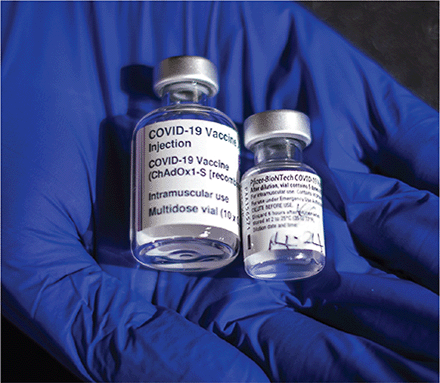Science‘s COVID-19 reporting is supported by the Heising-Simons Foundation
Faced with short supplies of COVID-19 vaccines and unforeseen side effects, some countries have adopted an unproven strategy: switching shots midstream. Most authorized vaccines require two doses administered weeks or months apart, but Canada and several European countries are now recommending a different vaccine for the second dose in some patients. Early data suggest the approach, born of necessity, may actually be beneficial.
In three recent studies, researchers have found that following one dose of the vaccine made by AstraZeneca with a dose of the Pfizer-BioNTech vaccine produces strong immune responses, as measured by blood tests. Two of the studies even suggest the mixed vaccine response will be at least as protective as two doses of the Pfizer-BioNTech product, one of the most effective COVID-19 vaccines.
Only a few of the potential vaccine combinations have been tested. But if mixing vaccines proves safe and effective, it could speed the effort to protect billions of people. “This possibility opens new perspectives for many countries,” says Cristóbal Belda-Iniesta, a clinical research specialist at the Carlos III Health Institute. Governments, for example, could immediately distribute new doses without worrying about setting aside second shots of specific vaccines to give people weeks or months later.
Europe and Canada have an added incentive. Millions of people there received an initial dose of the AstraZeneca vaccine before governments recommended younger age groups avoid it because of the risk of a rare clotting disorder. They were left wondering what to do next: Get a second dose or switch to a different vaccine?
In a Spanish study that Belda-Iniesta helped lead, 448 people who received a dose of the Pfizer-BioNTech vaccine 8 weeks after an initial AstraZeneca dose had few side effects and a robust antibody response 2 weeks after the second shot. All 129 blood samples tested could neutralize a noncoronavirus expressing spike, the SARS-CoV-2 surface protein key to infecting cells, he and colleagues reported last month on The Lancet‘s preprint site.
Similarly, Leif Erik Sander, an infectious disease expert at the Charité University Hospital in Berlin, and colleagues found that 61 health care workers given the two vaccines in the same order, but 10 to 12 weeks apart, produced spike antibodies at levels comparable to a control group that received two doses of Pfizer-BioNTech at the standard 3-week interval, and had no increase in side effects. Even more encouraging, their T cells, which can boost the antibody response and also help rid the body of already infected cells, responded slightly better to spike than fully vaccinated Pfizer-BioNTech recipients. A team conducting a smaller study in Ulm, Germany, had comparable results. Both groups have posted preprints on the medRxiv server.


Initial data support giving a dose of AstraZeneca’s COVID-19 vaccine (left) followed by one of Pfizer and BioNTech’s (right).
PHOTO: VICTORIA JONES/PA IMAGES/GETTY IMAGES
“Two different vaccines may be more potent than either vaccine alone,” says Dan Barouch of Beth Israel Deaconess Medical Center, who helped develop the one-dose COVID-19 vaccine made by Johnson & Johnson. It and the two-dose AstraZeneca vaccine use a nonreplicating adenovirus as a “vector” to introduce DNA coding for the spike protein of SARS-CoV-2 into the recipient’s cells. Vaccines from Pfizer-BioNTech and Moderna instead use messenger RNA (mRNA) coding for spike, which cells take up and use to make the protein.
Mixing the two types of vaccine may give the immune system multiple ways to recognize a pathogen. “The mRNA vaccines are really, really good at inducing antibody responses, and the vector-based vaccines are better at triggering T cell responses,” Sander says. Matthew Snape, a vaccine expert at the University of Oxford, agrees the combination vaccine results so far are promising but cautions they don’t resolve whether any improvement in T cell response results from longer dose intervals rather than the mixing.
The recent studies are imperfect because they are not designed to assess actual protection against COVID-19. That would require following large groups receiving different vaccine combinations to see who gets infected and sick over many months. The antibody and T cell measurements the studies rely on are thought to correspond to real-life protection, but studies are ongoing to determine exactly how reliable these correlates are.
Still, the findings support recent policy changes. Spain has authorized the mixing of the two vaccines for people under age 60. Other countries that have put age limits on the AstraZeneca vaccine, including Canada, Germany, France, Norway, and Denmark, have made similar recommendations.
Snape and colleagues are also studying eight vaccine permutations in roughly 100 people each: a first dose of either AstraZeneca or the Pfizer-BioNTech vaccine, followed by a dose of either the same vaccine or the opposite, with intervals of either 4 or 12 weeks. The group reported in The Lancet last month that people who received the mRNA vaccine just 4 weeks after AstraZeneca’s suffered significantly more side effects than those who received two doses of the same vaccine; data on those subjects’ immune response are pending. The program has expanded to include second doses of Moderna’s mRNA vaccine and Novavax’s direct spike protein vaccine.
The research should also include vaccines widely used outside Europe, Snape says, such as those that rely on inactivated copies of SARS-CoV-2, developed by Chinese companies, and a Russian formulation using different adenoviruses in two doses. Mixing shots, Snape concludes, “will be the reality for many countries around the world aiming to make best use of the vaccines available to them.”


